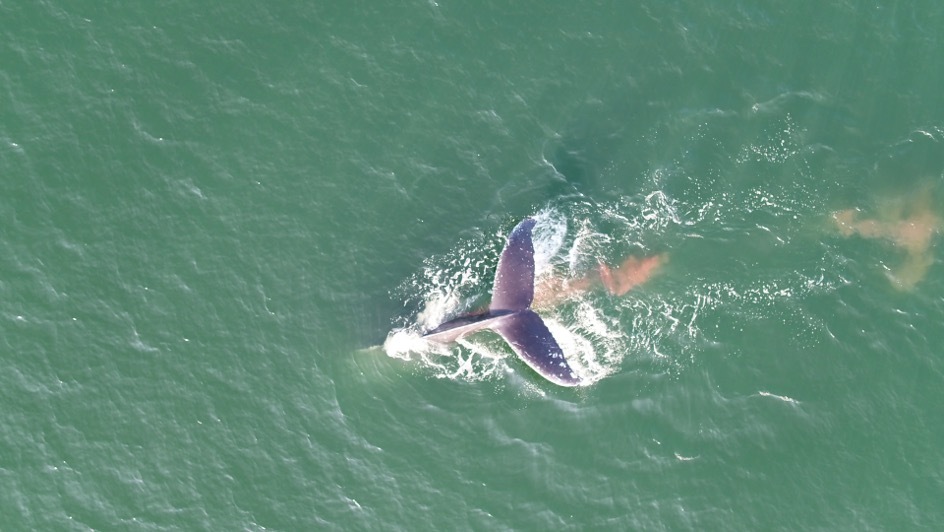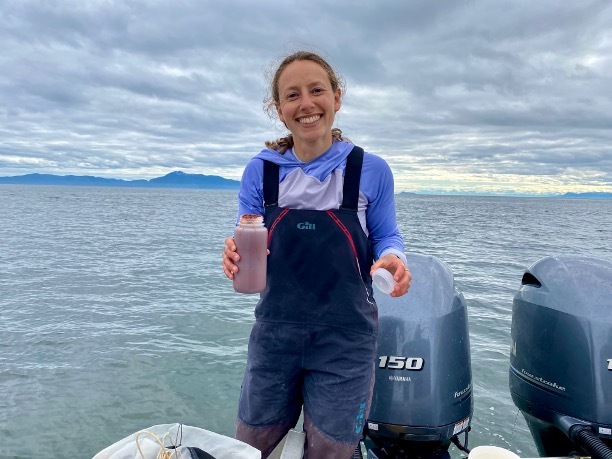
(Photo courtesy of Martin van Aswegen, collected under National Marine Fisheries Service Permit Number 19703)
Humpback whales could be growing their own food supply and fighting climate change in a very unusual way — with their poo! KFSK’s Thomas Copeland has more on research happening this summer on the “whale pump hypothesis.”
The first time Dana Bloch ever saw a whale, she was in Provincetown, Massachusetts with her grandfather.
“I would usually fall asleep on the whale watches — I think, because it was a long boat ride out there,” said Bloch. “It was sunny and rocking. And when I was about seven, I was like: ‘I’m gonna stay awake and I’m going to see all the whales and spot them first!'”
And it was humpbacks in particular that Bloch fell in love with.
“They’re so, kind of like lumpy, bumpy and gangly,” said Bloch. “And they have this ridiculous shape. They’re mysterious and under the water like they’re just these giant mammals like blobbing around doing really cool stuff.”
Two decades later, Bloch crossed the continent to study some of that cool stuff going on under the waves, as part of a postgraduate degree at the University of Alaska Fairbanks. She’s looking into a process called the ‘whale pump hypothesis’. Bloch says it has four steps.
“Step one is: the whale is feeding on nutrient rich prey,” said Bloch. “And that could be krill, herring, maybe juvenile salmon or sand lance. Step two is the whales returned to the surface and they produce a fecal plume in the surface water.”
“Okay,” said Copeland. “But what is fecal plume in, like, normal language?”
“A giant cloud of whale poop,” said Bloch.
Bloch says the best way to spot the whale poop is from a drone.
“I have a picture here that you can see,” said Bloch, holding up a picture. “It’s like a red cloud that’s kind of coming from underneath the whale’s tail. It usually comes as the whale dives.”
But enough of what the poop looks like — it’s what the poop contains that really matters.
“Step three: the material in the whale poop is very rich in nutrients,” said Bloch. “In Southeast Alaska we’re mostly interested like phosphorus and nitrogen.”
And finally comes: Step Four.
“Phytoplankton are using the nutrients to grow and reproduce,” said Bloch.
So, there you have it: the four steps of the “whale pump hypothesis.” But wait — why should we care about phytoplankton? Bloch says there are two reasons why. The first is that phytoplankton are the base of the ocean food chain. Everything else relies on it, including the fish that whales eat. And that’s why Dana says humpbacks could be like gardeners of the sea.
“It’s like they’re fertilizing the area where their food may be growing,” said Bloch. “And in that sense, the whales may be kind of in less competition with the fisheries or with other ocean needs than we sometimes think.”
And the second reason we should care about phytoplankton is even more important.
“They’re primary producers that are responsible for about 50% of the oxygen in the air,” said Bloch. “So they’re responsible for every other breath you take.”
“50% of the oxygen produced in the world is from phytoplankton… What?!” said Copeland.
“Yeah, some estimates are higher,” said Bloch. “But that’s a ballpark estimate.”
“I thought trees produced all the oxygen,” said Copeland.
“Trees produce a lot of the oxygen, but the oceans are giant and cover most of the earth,” said Bloch.
Plus, when the phytoplankton die, they sink to the bottom of the ocean, storing all that carbon far away from the surface. Now, superhero phytoplankton sound really cool — but Bloch’s job is a little less glamorous. She works with the Alaska Whale Foundation out of Warm Springs Bay to collect the data she needs. She has a video of herself hanging off the side of the boat with a white net in her hand.
“When the drone pilot says like ‘okay, go ahead,’ I drop a small phytoplankton net into the water and just run it through the fecal plume,” said Bloch. “I pull it out and transfer that into a bottle and put it in the freezer next to our frozen berries.”
“What does it smell like?” asked Copeland.
“It smells awful,” said Bloch. “It smells like fishy poop. I mean, it is fishy poop, so…”

Bloch says that there’s lots more work to be done in the future. But when she’s out on the water, Bloch thinks back to her grandfather’s boat in Massachusetts.
“And if I told my seven-year-old self, I wouldn’t have believed myself then because it’s just, like — that’s way too cool,” said Bloch.
“Even if it involves scooping up whale poo,” said Copeland.
“Yeah, whale poo I don’t think I would have anticipated,” said Bloch.
Bloch will continue her research until the spring of 2024 — so there’s plenty of time for her to fully digest all the data she collects this summer.











